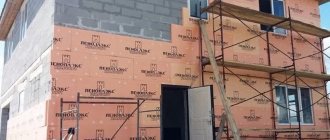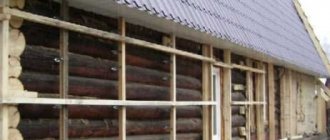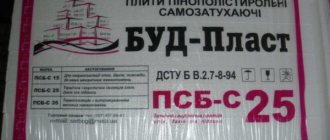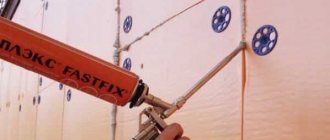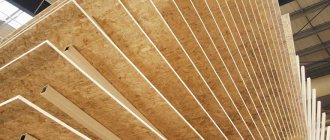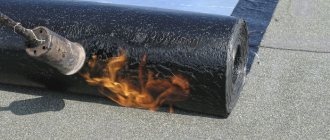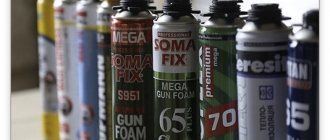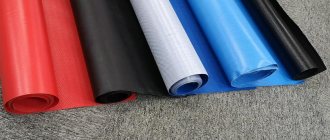Penoplex is a building heat-insulating material in the form of slabs of extruded polystyrene foam, in demand due to its lightness, strength and durability. In structure, it is similar to the usual polystyrene foam, but is more dense.
The barely visible pores of the insulation, measuring from 0.1 to 1 mm, are the result of new manufacturing technologies. In appearance, the slabs consist of a homogeneous material, which is actually finely porous with insulated cells, providing low thermal conductivity and water resistance.
A variety of grades and enhanced strength allow it to be used for insulating floors, roofs, and foundations.
Types, technical characteristics and purpose
Since 2011, product differentiation has been introduced depending on the purpose and area of application. This allows you to quickly find out the type of insulation you need with a set of characteristics for a specific type of work and promotes maximum efficient use.
Several types of extruded polystyrene are available:
WALL, or penoplex 31 with fire retardants
Designed for insulation of surfaces without dynamic or static load. Optimal for insulating facade walls, partitions, swimming pools, wells, heating networks, water supply systems.
Characteristics:
| Properties | Unit | Index |
| Thermal conductivity, 25°С | W/(mK) | 0,03 |
| Density | kg/m3 | 25,0–32,0 |
| Strength | MPa (kgf/cm2; t/m2) | 0,20(2,0; 20) |
| Water permeability, 28 days | % by volume | 0,5 |
| Fire protection | group | G3 |
| Working temperature | С° | from -50 to +75 |
FOUNDATION, or penoplex 35 without fire retardant
The slabs are designed for heavy loads and are durable. Ideal for road surfaces, foundations, floors, and basement equipment. The presence of a waterproofing barrier allows groundwater to be drained from the underground part of the house.
Characteristics:
| Properties | Unit | Index |
| Thermal conductivity, 25°С | W/(mK) | 0,03 |
| Density | kg/m3 | 29,0–33,0 |
| Strength | MPa (kgf/cm2; t/m2) | 0,27 (2,7; 27) |
| Water permeability, 28 days | % by volume | 0,5 |
| Fire protection | group | G4 |
| Working temperature | С° | from -50 to +75 |
ROOFING, or penoplex 35
The slabs are designed for insulation of roofs and attic spaces of any type, taking into account climatic precipitation and temperature changes. Currently, it is used for flat roofs with winter gardens or parking lots placed on it (inversion roofing).
Characteristics:
| Properties | Unit | Index |
| Thermal conductivity, 25°С | W/(mK) | 0,03 |
| Density | kg/m3 | 28,0–33,0 |
| Strength | MPa (kgf/cm2; t/m2) | 0,25 (2,5; 25) |
| Water permeability, 28 days | % by volume | 0,5 |
| Fire protection | group | G3 |
| Working temperature | С° | from -50 to +75 |
COMFORT, or penoplex 31C
Universal slabs are suitable for insulating loggias, balconies, walls and floors of saunas, and mansions. It is characterized by increased moisture resistance and provides an optimal microclimate. Due to technical features, slabs of this type are particularly tightly adjacent to each other.
Characteristics:
| Properties | Unit | Index |
| Thermal conductivity, 25°С | W/(mK) | 0,03 |
| Density | kg/m3 | 25,0–35,0 |
| Strength | MPa (kgf/cm2; t/m2) | 0,20 (2,0; 20) |
| Water permeability, 28 days | % by volume | 0,5 |
| Fire protection | group | G4 |
| Working temperature | С° | from -50 to +75 |
Penoplex 45
It is used for thermal protection of take-off surfaces and roads, protects against subsidence, deformation, and swelling of the canvas. Designed for heavy loads: can withstand the weight of an aircraft in regions with low temperatures. The strongest material retains its properties for a long time.
Characteristics:
| Properties | Unit | Index |
| Thermal conductivity, 25°С | W/(mK) | 0,03 |
| Density | kg/m3 | 35,0–47,0 |
| Strength | MPa (kgf/cm2; t/m2) | 0,50 (5,0; 50) |
| Water permeability, 28 days | % by volume | 0,4 |
| Fire protection | group | G4 |
| Working temperature | С° | from -50 to +75 |
Insulation of aerated concrete house with Penoplex
Step 1. Let's look at how a house made of aerated concrete is insulated using Penoplex. So, the first thing you need to do is build the foundation of the building.
First the foundation is built
Step 2. Next, cut-off waterproofing must be laid along the perimeter of the foundation and along the perimeter of all load-bearing walls.
Laying cut-off waterproofing
Step 3. After this, using standard technology, you need to build walls from aerated concrete blocks to the level of the upper border of the window and door openings.
Construction of house walls
Step 4. The next stage is the installation of window and door openings, and here the use of Penoplex begins. The material is laid on top of the window opening, and then, above it, perpendicular to it, you need to install two pieces of Penoplex, tighten them together with ties.
The material is laid on top of the window opening
Two pieces are installed on top
The segments are contracted
Step 5. Between two sections of Penoplex it is necessary to lay reinforcing bars and continue further construction of walls. The rods will connect two gas blocks lying along the edges of the window opening.
Laying reinforcing bars
The rods will connect two gas blocks together
Step 6. The cavity between two sections of Penoplex needs to be filled with concrete.
The cavity is filled with concrete
Step 7. In this way you need to arrange all the door and window openings.
All door and window openings are equipped
Step 8. After this, formwork is created for arranging the ceiling of the second floor
If there is a staircase in the house, it is important to leave an opening for it according to the design
The formwork is being created
Step 9. Now you should cover the formwork with sheet material, creating a full overlap.
Don't forget to leave an opening for the stairs
Step 10. Next, Penoplex should be laid around the perimeter of the building at the floor level. If necessary, the slabs are cut according to the building design.
Laying material around the perimeter of the building
Step 11. After this, the reinforcing mesh is laid and the floor surface is filled with concrete. That is, you need to make a concrete screed. Work can be continued after 7 days.
Pouring concrete
Step 12. The next step repeats step 2 in this instruction - you need to lay the waterproofing.
Waterproofing is being re-installed
Step 13. Next, you need to build the second floor of the house, not forgetting to finish the window and door openings with Penoplex as in the previous steps.
Second floor erected
Step 14. After installing the roof, you can use heat guns to dry the inside of the house.
Drying the house from the inside
Step 15. Now that the building has been erected, you can begin to insulate the facade of the house using insulation boards.
You can start insulating the facade
Step 16. First, Penoplex slabs need to be placed on glue. It must be applied to each slab along the perimeter, 1-3 cm from the edge, as well as to the middle of the slab from one edge to the other along the length.
Applying glue to the slab
Step 17. The slabs need to be glued along the entire facade.
Gluing slabs to the facade
Result of work
Step 18. Now you need to prepare holes for the dowels by drilling both the Penoplex and the concrete underneath to the required depth, focusing on the length of the dowel.
Drilling holes
Depth depends on dowel length
Step 19. Using anchors for aerated concrete, Penoplex is additionally attached. You can knock out the dowel with a hammer.
Anchor for aerated concrete
There should be a small gap
Step 20. Fixing one Penoplex slab with dowels is done in two places in the middle and along the perimeter of the slab (corners, middle of the long side).
Additional fixation of Penoplex
Step 21. Now Penoplex can be processed mechanically, making it rough, and covered with reinforcing plaster and adhesive material. All that remains is to complete the finishing touches, and the insulation of the house is complete.
Mechanical processing of material
Application of a base reinforcing plaster-adhesive layer
Dimensions, thickness and cost
The stability of thermal insulation properties allows the use of slabs of medium thickness from 35 to 50 mm. This is average for a standard solution in a temperate climate.
Increased thickness of penoplex up to 70 mm or more is used in northern regions, where temperatures often drop to -300 C. This approach is justified, especially since the usual thickness of other insulation materials reaches 150 mm.
The dimensions of the slabs are standardized by the manufacturer to standard 1200 mm in length and 600 mm in width.
Compared to other types of insulation, the cost of penoplex is quite high: the price of 1 square meter of sheet is on average $5. If the material is modified with improved qualities, including fire retardant additives, then the price will be $7-8 per 1 sq.m.
What is
Purely externally, penoplex resembles ordinary polystyrene foam, well known to many. However, such slabs have a higher density, are more expensive and can serve as insulation for much longer. Penoplex is much more resistant to ultraviolet radiation and other adverse environmental factors.
Modern industry produces many varieties of penoplex, differing in technical characteristics. One of the most popular types of this material are 50 mm sheets. Penoplex of this thickness has standard dimensions, weighs little, and therefore is very convenient to use, transport and store. The scope of its application is very wide.
Production technology and scope
The specifics of penoplex manufacturing are aimed at improving the strength and technical characteristics of the material.
It is given special properties by the process of extrusion from raw materials in special furnaces. First, polystyrene granules are mixed with a foaming agent under conditions of high humidity and temperature. The catalyst is a composition of carbon dioxide (CO2) and freon. The polystyrene foam composition is melted in ovens and resembles lush cream.
Then, through the extrusion installation, the substance begins to be squeezed out, the freon gradually evaporates, and the cells are filled with simple air.
The use of penoplex in the construction industry has practically no restrictions and, thanks to its technical characteristics, can significantly reduce the costs of other consumables and energy resources.
Currently, heat insulation is in demand in different climatic conditions for insulation and protection:
- foundations and walls of low-rise buildings;
- balconies and loggias;
- pools and wells;
- ceilings and basements;
- floors and ceilings;
- water supply systems;
- airfield runways;
- railways and roads;
Penoplex of various categories is widely used in the process of reconstruction of buildings due to its high resistance to environmental changes and chemical influences. The material is used to make sandwich panels.
How do they do it?
This material is produced at enterprises from polystyrene granules using various kinds of additives, which ultimately improve its performance qualities. In the production of penoplex, the initial raw materials are previously exposed to high temperatures under high pressure. Next, a special catalyst for foaming is added to the mass. Then substances are added to the penoplex that increase its fire-resistant properties, ability to resist ultraviolet radiation, etc.
Material properties
The main characteristics of the insulation meet the requirements of building regulations:
- Low thermal conductivity coefficient. The average level corresponds to 0.027–0.031 W/m. The indicator is the best in the class of insulation. At the same time, its difference from related materials, for example, mineral wool, is not so significant. But the combination of low thermal conductivity with increased structure density provides noticeable advantages. An important factor is the constancy of the indicator; significant fluctuations in different conditions are not recorded, therefore the use of penoplex is allowed without an additional moisture-proof layer both on roofs and attics, and on foundations, floors, and basements.
- Fire resistance. Fire resistance is characterized by categories G3 or G4, which means a moderate level that exceeds the properties of foam plastic that supports combustion. Operating temperatures from -50° to +70°C are acceptable for polystyrene foam. In open fire conditions, the material is destroyed. The melting process begins, but not combustion. Some types of penoplex are characterized by enhanced treatment with chemical reagents to exhibit self-extinguishing. This improved quality corresponds to complete fire safety under extended operating temperature conditions.
- Moisture resistance. Water absorption of extruded polystyrene foam is 0.4% of the volume over a period of 28 days. Moisture enters only into the external pores of the insulation, which are opened when cutting and installing the slabs. Closed cells are kept unchanged. In fact, it can be argued that the material does not allow moisture to pass through. For insulation of facades and roofs of buildings, such moisture resistance indicators are very significant.
- High compressive elasticity. This figure is 25-35 kg/m3 and is unsurpassed among polystyrene foam insulation. Compressive resistance is achieved through the uniform distribution of tiny cells with good adhesion, improving the strength characteristics of the material. Penoplex does not change dimensions even under heavy loads. The slabs are very difficult to break. Only material with a small thickness of 20 mm is subject to damage, but there is no crumbling or crushing along the fault line, unlike other related insulation materials.
- Weak vapor permeability. Increased resistance is reflected in equal indicators of penoplex with a height of 2 cm and a layer of roofing material.
- Long service life. The warranty period for use is 50 years, taking into account atmospheric exposure. Under favorable climatic conditions, the slabs will last much longer while maintaining all their characteristics.
- Environmental friendliness. The use of freon in the manufacture of insulation is absolutely harmless: this type is non-flammable, non-toxic, and does not cause destruction to the ozone layer. Environmental properties are interconnected with the biostability of the insulation and the absence of toxic substances. The material is not subject to biological decay, therefore it does not require special storage conditions; the slabs can be placed on sites without shelter from precipitation or temperature changes.
- Availability of installation and processing . You can cut the slab with a regular stationery knife. The low weight allows you to cover the walls yourself without additional effort in constructing special frames. The material adheres well to glue. Weather conditions do not interfere with installation.
- Resistance to aggressive substances. Most construction mixtures and preparations are not capable of damaging penoplex, which does not react with them. These include organic and inorganic acids, alkalis, water-based paints, salt solutions, ammonia, cement or concrete mixtures, alcohols and oils, bleach. Extruded polystyrene foam has virtually no chemical activity. Attention! The exceptions are ethers, gasolines, formaldehydes, and oil-based paints.
- High sound insulation. In private housing construction, the noise insulation factor is very important. Penoplex solves this problem.
Recommendations
When purchasing penoplex, you should pay attention to the labeling of the product, the safety of the packaging, and the technical characteristics of the material. It is worth buying 10% more material from the measured initial quantity, in case it is rejected during use. It is necessary to work with the material carefully, since if its integrity is damaged, water may get inside, which will shorten the service life of the material. It is better to use the services of professionals or read the instructions yourself and work with penoplex correctly.
Due to the possibility of toxic vapors being released under the influence of UV rays on penoplex, its use outside is considered optimal. The insulation must be treated with mesh plaster or other façade material on top of the insulation.
It is not worth covering the insulation with a water-repellent agent, because the penoplex itself is waterproof. You should be careful when you are near penoplex with other substances. Some of them can destroy the cellular structure of the slab
As a result, its technical performance will deteriorate.
Penoplex slabs should be used in the range of -50… +75 degrees. At this temperature, all the characteristics of the material are perfectly preserved. They can be stored for a long time in the manufacturer's packaging, but they should be protected from direct exposure to sunlight.
When choosing penoplex, the question is how to make the correct calculations of raw materials. For this purpose, many manufacturers’ websites have a special calculator. In it you can indicate the area of the surface to be insulated, and he himself will calculate the amount of material required.
Before you begin installing penoplex, you need to complete several points:
Preparation of the working surface, this is especially important for walls. It is necessary to remove all dirt and smooth the surface of the wall. If necessary, it is worth treating the facade walls with a primer. To fix the slabs, a special mixture with an adhesive base is prepared. To prevent the slabs from moving due to wind, they are additionally secured with fasteners.
See below for a master class on floor insulation with penoplex.
Advantages and disadvantages
The positive features of insulation are manifested at all stages of use of this material:
- Lightweight slabs are easy to prepare and process and do not require special knowledge and skills to operate.
- They are attached in different ways and do not require additional layers of vapor and waterproofing.
- Excellent thermal insulation qualities allow you to save on other building materials.
- Durability and strength in any climate tests.
- Safety and environmental friendliness.
The disadvantages of the new generation material include:
- Susceptibility to attacks by rodents , which is typical for all types of insulation.
- Emission of acrid smoke when decomposed by open fire.
- Does not withstand combination with kerosene , gasoline or diesel fuel.
- Insufficient sound insulation compared to materials intended for this purpose.
- High prices for various types of penoplex, comparable to expensive mineral wool.
What is contact allowed?
The advantage of 50 mm penoplex insulation, among other things, is that it is resistant to various types of paints, mortars, acids and alkalis. For example, such boards do not collapse upon contact with butane, ammonia, animal and vegetable fats, alcohol and water-based paints.
Penoplex material is resistant to various chemicals. However, some such substances can still have a negative effect on it. These include, for example:
- gasoline and kerosene;
- tar;
- oil paint;
- epoxy resin;
- acetone and xylene;
- formaldehyde;
- toluene;
- formalin;
- diethyl alcohol.
Advantages of sprayed insulation
This insulation material has a number of priority advantages, successfully competing with any roll and slab thermal insulators.
A feature of sprayed insulation is the simplicity of the insulation process. For this purpose, a high-pressure cylinder unit is used, through which two structural components are sprayed and, when combined, form polyurethane foam.
Many people have probably seen a similar material like this when using polyurethane foam to insulate window openings. Sprayed wall insulation looks similar.
Sprayed insulation is quite light in weight and can be applied to a surface of any material in a layer of any thickness without consequences.
Strength of insulation
It is easy to compare products by density if you use equipment for this. The mechanical compressive strength at a deformation of 10% of Penoplex type 35 is the same as that of Technoplex “XPS30-200 Standard”. As a result, the indicator for both one material and the other is 250 kPa.
As for the bending strength limit, Penoplex has an average value of 0.4 to 0.7 MPa. With strong bending, Technoplex has a strength limit of 0.3 MPa. It turns out that the first material has better resistance to bending, which is applied to it, and therefore is able to withstand heavy loads. It all comes down to the fact that the strength of insulation directly depends on its density. And with Penoplex it is higher.
History of appearance
Penoplex is a material produced by extrusion. Its appearance was impossible without the appropriate equipment. This type of machine first appeared in the USA more than fifty years ago. As a result of several experiments, it was possible to arrive at exactly the form that penoplex has today. In fact, the word “penoplex” has become a common noun from the name. It is he who has been the leader in the production of this material in Russia since 1998. The production process itself is quite simple, but requires sophisticated equipment.
Penoplex insulation is based on polystyrene granules. They melt under the influence of temperature to a homogeneous liquid mass. The process occurs at 140° Celsius. After this, substances are added to the resulting mass, which, when heated, begin to release gases. The latter create foam inside the polystyrene mass. The bubbles do not burst or float up, but remain in the melt. During this stage, additional substances are introduced, which, for example, increase resistance to open fire, preventing the finished product from igniting, but only melting. Other additives include antioxidants. Their task is to extend the service life of the finished product under the influence of various factors, in particular air, which contains oxygen.
Antistatic agents are mandatory in penoplex insulation. The fact is that during installation, a large amount of static energy can accumulate on the sheets, which can harm electrical appliances. After the solution is completely ready, it is squeezed out through a special molding hole in the extruder. The formed elements enter the conveyor and move further. The final product consists of only 2% polystyrene and additives; the rest is occupied by gases formed from the catalysts. At the same time, the size of the bubbles is correct due to formation under pressure. Below is a video about the production of penoplex.
Adhesive selection parameters
Insulation is produced in the form of slabs of various sizes. The scope of application of the material is extremely wide. It is used for thermal insulation of walls, ceilings, floors, as well as for insulation of roofs, facades and even foundations.
Take a closer look at the video:
In order to choose the right way to glue penoplex, you need to take into account several parameters:
frost resistance of the composition is an important characteristic of the adhesive when it comes to outdoor work; the adhesive properties of the composition must correspond to the characteristics of the insulated surface. Cement adhesive for penoplex has the highest adhesion; in rooms where the finishing should also perform a moisture-proof function, it is advisable to use compounds with a waterproofing function
Cement mixtures serve much less in such conditions; Without having the skills to install penoplex, it is also necessary to take into account the rate of hardening of the composition. Polymer materials set in a few seconds; only experienced specialists can work with them; the cost of the adhesive composition is also an important characteristic when choosing. In order to save money, preference can be given to dry mixtures, which are significantly cheaper than a ready-to-use product.

